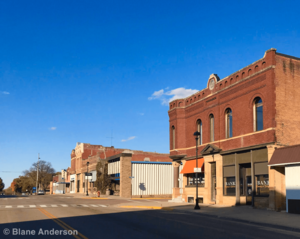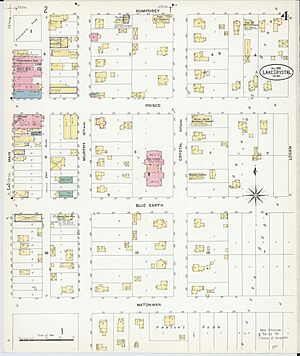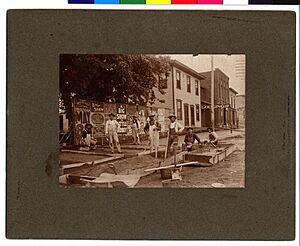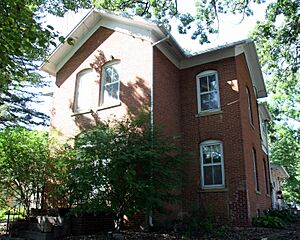Lake Crystal, Minnesota facts for kids
Quick facts for kids
Lake Crystal
|
|
|---|---|

Main Street in 2019
|
|
| Motto(s):
"The Place To Be"
|
|

Location of Lake Crystal, Minnesota
|
|
| Country | United States |
| State | Minnesota |
| County | Blue Earth |
| Government | |
| • Type | Mayor - Council |
| Area | |
| • Total | 1.71 sq mi (4.42 km2) |
| • Land | 1.71 sq mi (4.42 km2) |
| • Water | 0.00 sq mi (0.01 km2) |
| Elevation | 994 ft (303 m) |
| Population
(2020)
|
|
| • Total | 2,539 |
| • Density | 1,488.28/sq mi (574.60/km2) |
| Time zone | UTC-6 (Central (CST)) |
| • Summer (DST) | UTC-5 (CDT) |
| ZIP code |
56055
|
| Area code(s) | 507 |
| FIPS code | 27-34190 |
| GNIS feature ID | 2395588 |
| Website | https://www.lakecrystalmn.org/ |
Lake Crystal is a small city in Blue Earth County, Minnesota, United States. It was founded in 1869. About 2,539 people lived there in 2020. Lake Crystal is part of the larger Mankato-North Mankato area.
Contents
Discovering Lake Crystal's Past
Early Settlers Arrive (1850s)
In 1853, two families from Ithaca, New York, decided to move west. William Riley Robinson, 32, was one of them. In June 1854, Robinson and his friend Lucius O. Hunt traveled from Wisconsin to Blue Earth County.
They found three beautiful lakes: Loon, Crystal, and Lily. They were so impressed that they went back for their families. Then, they returned to settle near Lake Crystal. Two other families, led by Calvin Webb and Samuel Thorne, joined them.
Robinson's family built a log cabin on the south shore of Crystal Lake. Hunt's family settled in a log cabin on the south shore of Lily Lake. Each man claimed a large piece of land. President James Buchanan signed the deeds for their land.
During the Dakota War of 1862, the settlers had to leave their homes. They went to a fort in Mankato for safety. After the conflict ended, they came back and rebuilt their homes. Hunt built a brick house in 1869, which was later taken down. Robinson built his brick house in 1870, and it is still a historic building today.
How Lake Crystal Began (Late 1800s)
In 1857, there was a plan for a town called Crystal Lake City. It was supposed to be on the southwest shore of Crystal Lake, but it never happened.
In October 1868, a railroad line was finished in the area. This was the Valley Railroad, which later became the Chicago, St. Paul, Minneapolis, & Omaha Railroad. The railroad chose Lake Crystal as a new station.
So, Lake Crystal officially started along the railroad in 1869. Robinson and Hunt planned out the town. The railroad's engineer, General Judson W. Bishop, named the town after nearby Crystal Lake. A post office opened in Lake Crystal in 1869.
By December 1869, the town had many businesses. These included a grain elevator, a hotel, a school, and several stores. Lake Crystal became an official city on February 24, 1870. Its first newspaper, The People's Journal, started in March 1870.
The years between 1870 and 1895 were known as the “Wheat Era.” Most local farmers grew a lot of wheat.
Challenges and Growth
In 1873, millions of grasshoppers attacked the area. They ate all the crops, which hurt Lake Crystal's economy. The grasshopper problem lasted until June 1877. It took years for the town to recover. By 1882, farmers were selling good amounts of wheat again.
In 1879, another railroad line, the Elmore line, was completed. Lake Crystal became a busy junction for trains. More than 20 trains passed through town every day!
In 1882, a new two-story brick schoolhouse was built. It was expanded later but taken down in 1972. In 1885, a volunteer fire department with 16 men was started. This was important because there were several fires in the town.
On September 20, 1887, a big fire broke out in the business area. It was put out with help from the Mankato Fire Department. About seven buildings were damaged or destroyed.
Many churches were built in the late 1800s:
- All Angels Episcopal Church (1887)
- United Methodist Church (1890)
- Norwegian Lutheran Church (1893), later Zion Lutheran
- Catholic Church (1896)
- Welsh Calvinistic Methodist Church (1899)
In 1893, the Lake Crystal Boat Club built a boat pavilion at Robinson Park. They also launched a steamship called the New Era. It is thought to have sunk near the lake's south shore.
The Graif Brothers Flour Mill was built in 1894. It sold flour to places like Iowa, Wisconsin, Illinois, and even Glasgow, Scotland. By 1895, Lake Crystal had over 1,100 people.
In 1898, Lake Crystal got electricity! Power lines were installed on 16 streets.
Lake Crystal in the 1900s
The Graif Brothers Flour Mill burned down in 1901. A new one, the Lake Crystal Milling Company Plant, was built in 1902. It was taken down in the late 1980s. The First National Bank building was built in 1902.
In 1905, the main railroad station was moved north to Lily Lake. In 1908, the first water tower was built. It was about 110 feet tall and was taken down in 1995.
On October 10, 1919, the Lake Crystal American Legion Post 294 was started by 15 World War I veterans. Also in 1919, Main Street was paved, and the sewer system was fixed. The Lake Crystal Tribune newspaper began publishing weekly in December 1921.
A new hospital opened on Main Street in 1926. A new school addition was also built that year, but it was demolished in 2007. The City Municipal Power Plant was built in 1937 and still provides power today.
On January 1, 1937, an accidental fire destroyed the Welsh Calvinistic Methodist Church. The current First Presbyterian Church was built in its place that same year.
More churches were built:
- Trinity Lutheran Church (1947)
- Holy Family Catholic Church (1951)
- Zion Lutheran Church moved to its current location (1957)
In 1959, the Crystal CO OP elevator was built. It had huge grain bins added in the 1960s and 1970s. Highway 60 was moved and became a four-lane highway in 1968.
A new post office was built in 1970 and is still used today. An elementary school was built in 1971. In 1973, the Lake Crystal National Bank moved to a new building.
By 1978, the city's population reached 2,068. In the 1970s, some historic buildings were replaced by the Lake Crystal Towers, a five-story apartment building. A new City Hall was built in 1980 and expanded in 2017.
In 1983, Crystal Valley built a new concrete grain elevator. It added more large bins in 1985. Also in 1983, the Baptists moved to a new church. A new wastewater treatment plant opened in 1987.
The Elmore railroad line was removed in the 1980s. A new Lake Crystal Fire Hall was built in 1988. In 1995, a new tan-colored water tower was built. In the late 1990s, Crystal Gardens housing developments were built, adding 40 homes.
Lake Crystal in the 2000s
A public recreation center opened in 2000. It has a pool, gym, walking track, and exercise room. In the early 2000s, new housing areas like Lily Lake Estates and Crystal Creek began to be built.
POET Biorefining built a new ethanol plant near Highway 60 in 2004. In 2005, Kevin's Market Grocery Store was built where several old houses used to be.
In 2007, a new secondary school was built. Crystal Seasons Senior Living Center was built in 2008, replacing an older retirement home. The United Methodist Church moved and became Cornerstone UMC in 2015.
The Crystal Waters Project has been working to clean up the nearby lakes. These lakes had been affected by farming over the years. On August 8, 2016, a storm badly damaged the 57-year-old Crystal CO OP Elevator. It was taken down in the following months. In 2018, the water tower was repainted light blue.
Exploring Lake Crystal's Geography
The city of Lake Crystal covers about 1.72 square miles (4.42 square kilometers) of land. There are four lakes close to the city: Crystal Lake, Lily Lake, Mills Lake, and Loon Lake.
- Crystal Lake is the biggest lake and is in the center of town. You can go fishing, use public boat landings, and enjoy water sports there.
- Loon Lake also has public and private landings for fishing.
- Lily Lake is the smallest lake, good for canoeing and kayaking.
Minnesota State Highway 60 is a main road that runs through Lake Crystal.
Understanding Lake Crystal's Population
| Historical population | |||
|---|---|---|---|
| Census | Pop. | %± | |
| 1870 | 360 | — | |
| 1880 | 483 | 34.2% | |
| 1890 | 824 | 70.6% | |
| 1900 | 1,215 | 47.5% | |
| 1910 | 1,055 | −13.2% | |
| 1920 | 1,204 | 14.1% | |
| 1930 | 1,173 | −2.6% | |
| 1940 | 1,319 | 12.4% | |
| 1950 | 1,430 | 8.4% | |
| 1960 | 1,652 | 15.5% | |
| 1970 | 1,807 | 9.4% | |
| 1980 | 2,078 | 15.0% | |
| 1990 | 2,084 | 0.3% | |
| 2000 | 2,420 | 16.1% | |
| 2010 | 2,549 | 5.3% | |
| 2020 | 2,539 | −0.4% | |
| U.S. Decennial Census 2020 Census |
|||
Population Details (2010 Census)
In 2010, there were 2,549 people living in Lake Crystal. There were 1,063 households and 661 families. The city had about 1,482 people per square mile.
Most people (97.3%) were White. Other groups included African American (0.8%), Native American (0.2%), and Asian (0.7%). About 1.3% of the population was Hispanic or Latino.
About 33.3% of households had children under 18. Half of the households (50.0%) were married couples. About 31.7% of households were single individuals.
The average age in the city was 35.6 years old.
- 26.8% of residents were under 18.
- 6.5% were between 18 and 24.
- 27.9% were between 25 and 44.
- 25.2% were between 45 and 64.
- 13.5% were 65 or older.
The population was 47.9% male and 52.1% female.
Famous People from Lake Crystal
- Walter J. Croswell (1900-1991) was a farmer and a Minnesota state legislator. He lived on a farm in Lake Crystal.
- David Oppegaard (born 1979) is a novelist who was born in Lake Crystal.
- Richard E. Wigley (1918-1998) was also a farmer and a Minnesota state legislator. He lived on a farm in Lake Crystal.
See also
 In Spanish: Lake Crystal (Minnesota) para niños
In Spanish: Lake Crystal (Minnesota) para niños




